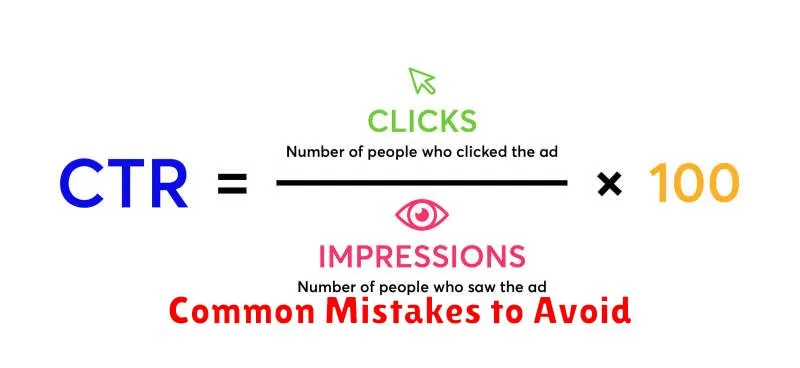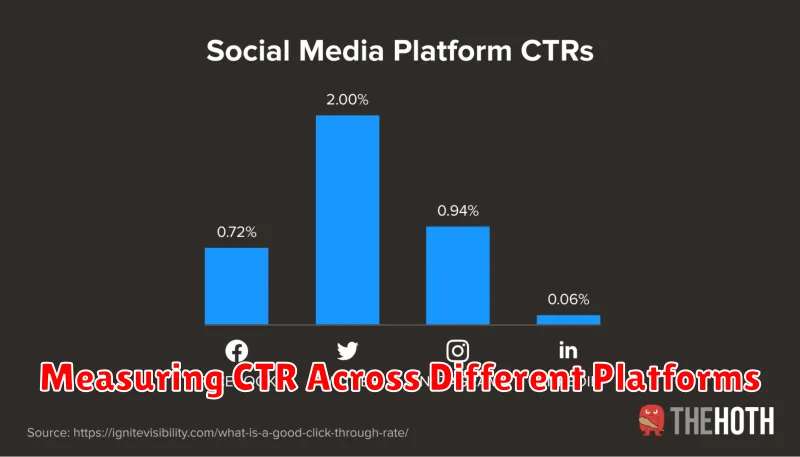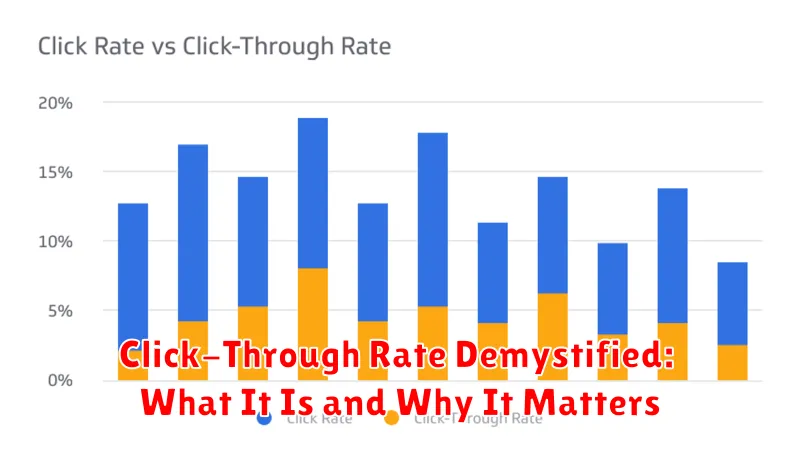Click-through rate (CTR) is a crucial metric in digital marketing, representing the percentage of users who click on a specific link, advertisement, or call to action after viewing it. Understanding and optimizing your CTR is essential for evaluating the effectiveness of your online campaigns, whether you’re focused on search engine optimization (SEO), pay-per-click (PPC) advertising, email marketing, or social media engagement. A high click-through rate indicates that your content resonates with your target audience and effectively drives traffic to your desired destination, ultimately contributing to increased conversions and business growth. This comprehensive guide will demystify the concept of click-through rate, explaining its calculation, significance, and practical applications.
This article delves into the intricacies of click-through rate, providing valuable insights into how to interpret and improve your CTR across various digital channels. We’ll explore the factors influencing click-through rates, including ad placement, targeting, compelling ad copy, and effective keyword utilization. By understanding the nuances of CTR and implementing the strategies outlined in this article, you can maximize the performance of your online campaigns, enhance user engagement, and ultimately achieve your marketing objectives. Learn how to leverage the power of a strong click-through rate to drive success in the competitive digital landscape.
What is Click-Through Rate (CTR)?
Click-through rate (CTR) is a key performance indicator (KPI) in digital marketing. It measures how often people click on a specific link, ad, or call to action when presented with the opportunity. Essentially, it quantifies the effectiveness of grabbing an audience’s attention and enticing them to take the desired next step.
CTR is expressed as a percentage. It reflects the proportion of impressions that result in a click. A higher CTR generally indicates a more successful campaign, appealing content, and effective targeting.
How to Calculate CTR
Calculating click-through rate (CTR) is straightforward. It’s the ratio of clicks to impressions, expressed as a percentage.
The formula is: (Total Clicks / Total Impressions) * 100 = CTR
For example, if an ad received 500 clicks and 10,000 impressions, the CTR would be:
(500 / 10,000) * 100 = 5%
Therefore, the CTR for that ad is 5%. This means that 5% of the people who saw the ad clicked on it. Tracking and analyzing CTR is crucial for evaluating the effectiveness of online advertising campaigns, email marketing, and other digital marketing strategies.
Why is CTR Important?
Click-through rate (CTR) is a key performance indicator (KPI) for various online marketing strategies. It provides valuable insights into the effectiveness of your campaigns and helps you understand how well your content resonates with your target audience.
A high CTR generally indicates that your ads, listings, or search results are relevant and appealing to users. This can translate into increased website traffic, lead generation, and ultimately, higher conversion rates.
Monitoring CTR allows you to identify areas for improvement. A low CTR can signal that your content needs to be optimized, your targeting is off, or your call to action isn’t compelling enough. By analyzing CTR data, you can make data-driven decisions to refine your strategies and maximize your return on investment (ROI).
Furthermore, CTR plays a role in quality score calculations for platforms like Google Ads. A higher CTR can lead to a better quality score, which can lower your advertising costs and improve ad placement. This reinforces the importance of CTR as a metric for both organic and paid campaigns.
Factors Affecting CTR
Several factors influence click-through rates. Understanding these factors is crucial for optimizing your campaigns and achieving higher CTRs. These elements often interact with each other, creating a complex web of influence.
Relevance
Relevance is paramount. A user is more likely to click if the ad, search result, or link is directly related to their search query or interests. Ensuring tight alignment between user intent and content is essential for improving CTR.
Presentation
How you present your link heavily impacts CTR. Compelling ad copy, a clear call to action, and an eye-catching title or headline all contribute to attracting clicks. Visual elements, while not discussed here due to the prompt’s limitations, also play a significant role when applicable.
Positioning
Positioning significantly affects visibility. In search results, higher rankings generally result in higher CTRs. Similarly, ad placement within a webpage can influence how likely users are to see and click on it.
Targeting
Effective targeting ensures your content reaches the right audience. The more relevant your audience, the more likely they are to click. Targeting options vary depending on the platform and can include demographics, interests, and browsing behavior.
Timing
Timing can also be a factor. Certain campaigns may perform better during specific times of day, days of the week, or even seasons. Analyzing data and understanding your audience’s behavior is crucial for optimizing timing.
Benchmarks and Industry Averages
Understanding average CTRs for your industry can provide valuable context for evaluating your own performance. Keep in mind that these are just averages, and actual CTRs can vary significantly based on numerous factors.
Industry benchmarks offer a general idea of what kind of CTRs are considered typical. For example, in search advertising, average CTRs often hover around 2% for the top position, decreasing as you move down the search results page. Display advertising typically sees lower average CTRs, often less than 1%.
Email marketing CTRs also vary greatly depending on factors like industry, audience, and email content. Averages can range from 1% to 5%, with higher CTRs often associated with targeted and personalized campaigns.
It’s crucial to remember that these are just averages. Factors like ad targeting, quality score, and audience engagement significantly impact your specific CTR.
Improving Your CTR: Best Practices
Optimizing your click-through rate involves a multifaceted approach. Here are some best practices to consider:
Compelling Ad Copy
Write concise, engaging copy that highlights the unique value proposition of your product or service. Use strong action verbs and create a sense of urgency.
Targeted Keywords
Conduct thorough keyword research to identify the terms your target audience is searching for. Incorporate these relevant keywords into your ad copy and landing page content.
A/B Testing
Experiment with different ad variations to determine what resonates best with your audience. Test different headlines, descriptions, and calls to action. Continuously analyze the results and refine your approach based on the data.
Optimized Landing Pages
Ensure your landing page experience aligns with the promises made in your ad copy. A seamless transition between ad and landing page is crucial for converting clicks into customers.
Common Mistakes to Avoid

Several common pitfalls can hinder your CTR efforts. Avoiding these mistakes is crucial for maximizing your click-through rates.
Ignoring Your Target Audience
A common mistake is creating generic ads that don’t resonate with your specific target audience. Understanding your audience’s needs and preferences is crucial for crafting compelling ad copy and selecting relevant keywords.
Poor Ad Placement
Even the most compelling ad can fail if it’s not placed strategically. Careful consideration of ad placement, whether on a search engine results page or a social media platform, is essential for maximizing visibility and clicks.
Neglecting A/B Testing
Failing to A/B test different versions of your ads can lead to missed opportunities for improvement. Regular A/B testing allows you to identify what resonates best with your audience and optimize your ads for higher CTR.
Keyword Stuffing
Overloading your ad copy with keywords can appear spammy and deter users from clicking. Focus on using relevant keywords naturally within your ad copy to maintain readability and relevance.
Disregarding Mobile Optimization
With a significant portion of internet traffic coming from mobile devices, neglecting mobile optimization is a major mistake. Ensure your ads are responsive and display correctly on various screen sizes for a seamless user experience.
Measuring CTR Across Different Platforms

Understanding how to measure click-through rate across various platforms is crucial for a comprehensive view of your marketing performance. Different platforms often have their own built-in analytics tools and reporting metrics.
Search Engines: Platforms like Google Search Console provide detailed CTR data for organic search results. You can see how often your site appears in search results and how often users click through to your site from those results. Pay close attention to keywords and search queries driving traffic.
Social Media: Each social media platform (e.g., Facebook, Twitter, Instagram) offers insights into post performance, including CTR. These metrics can be found within the platform’s analytics dashboards. Track which posts resonate most with your audience and analyze the elements that contribute to higher click-through rates.
Email Marketing: Email marketing platforms provide metrics such as open rates and click-through rates for your email campaigns. Analyzing CTR alongside open rates provides a deeper understanding of email engagement. Subject lines, email content, and calls to action significantly influence CTR.
Online Advertising: Advertising platforms, such as Google Ads and social media advertising platforms, furnish detailed CTR reporting for your paid campaigns. Monitoring CTR is essential for optimizing ad spend and ensuring campaign effectiveness. A/B testing ad creatives and targeting options can significantly impact CTR.

